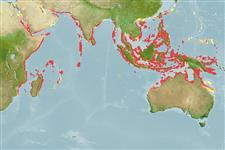Common names from other countries
Environment: milieu / climate zone / depth range / distribution range
экология
ассоциированный с рифами; пределы глубины 1 - 20 m (Ref. 98471). Tropical; 30°N - 25°S, 35°E - 155°E (Ref. 848)
Indo-West Pacific: East Africa including Red Sea to Guam, north to Philippines and south to Indonesia.
Length at first maturity / Size / Вес / Возраст
Maturity: Lm ? range ? - ? cm
Formation: mostly submassive. Corallites: cerioid to subplocoid, with moderately thin walls. Septa: thin and widely spaced; larger septa have very long teeth projecting upwards, causing a spiny appearance. Colonies usually not fleshy. Color: uniform or mottled brown, yellow, or green (Ref. 848).
Occurs in shallow reef environments (Ref. 848).
Life cycle and mating behavior
половая зрелость | размножение | нерест | икра | Fecundity | личинки
Members of the class Anthozoa are either gonochoric or hermaphroditic. Mature gametes are shed into the coelenteron and spawned through the mouth. Life cycle: The zygote develops into a planktonic planula larva. Metamorphosis begins with early morphogenesis of tentacles, septa and pharynx before larval settlement on the aboral end.
Основная ссылка
ссылки | координатор | соавторы
Scaps, P., V. Denis, S. Berhimpon and F. Runtukahu. 2007. (Ref. 83552)
Статус Красного Списка МСОП (Ref. 130435)
Статус СИТЕС (Ref. 108899)
Not Evaluated
Угроза для людей
Harmless
Использование человеком
| FishSource |
инструменты
дополнительная информация
Возраст/РазмерыростЗависимость между длиной и массой телаЗависимость между длинамиморфологияличинкичисленность
ресурсы в Интернет
Estimates based on models
Preferred temperature
(Ref.
115969): 26.7 - 29.3, mean 28.6 (based on 2847 cells).
